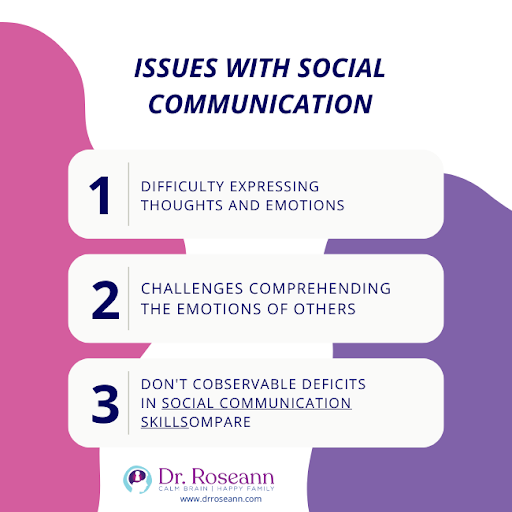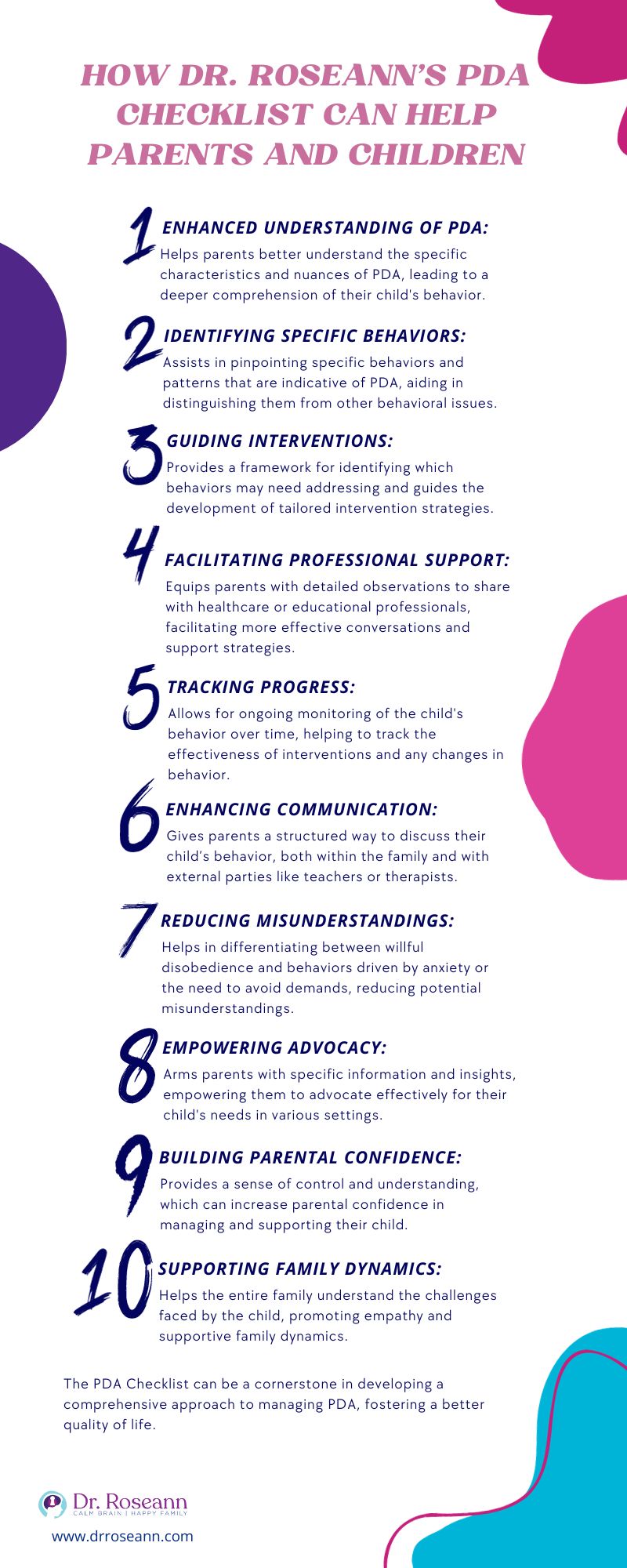Have you ever found yourself in a standoff with your child over seemingly trivial requests that seem to avoid like the plague? Perhaps your little one resists and avoids the ordinary demands of life, leaving you scratching your head in bewilderment. If so, you’re a parent who might want to explore Pathological Demand Avoidance. Our Pathological Demand Avoidance checklist can help you get the answers you need.
What is Pathological Demand Avoidance (PDA)?
Pathological Demand Avoidance is a condition that often goes unnoticed or misunderstood. It is a complex set of behaviors often associated with Autism Spectrum Disorder (ASD).
PDA is not a conscious choice to defy authority. Rather, it's a complex set of behaviors rooted in neurodevelopmental challenges, often associated with an autism diagnosis (Bishop, 2018). It is a behavioral profile characterized by a persistent resistance to meeting the demands of everyday life.
Children and adolescents with PDA display a remarkable aversion to routine requests and instructions, often going to great lengths to avoid demands and compliance. This goes beyond the typical defiance seen in children.
The avoidant behavior is not driven by a desire to be rebellious but rather serves as a coping mechanism to navigate a world that feels overwhelming and unpredictable. It manifests like pervasive developmental disorders of resisting and avoiding ordinary demands that extend across various settings.
Unlike straightforward disobedience, PDA involves a complex interplay of factors, including high levels of anxiety and an intense need for control. It reflects the child’s internal struggles and the external demands of their environment (Stuart et al., 2019).
These kids may employ a range of strategies to circumvent demands, such as negotiation, procrastination, or even exhibiting extreme behaviors. This makes it a distinct challenge for the child, their whole family, and those around them.
Signs and Symptoms of PDA in Children
So, how do you spot this elusive PDA profile? Look out for those little rebels who resist and avoid the ordinary like it's a life-or-death situation.
Here are the usual signs and symptoms of PDA in children:
1. Resistance to Routine Demands
- Verbal refusal to comply with ordinary or everyday tasks
- Displays of avoidance strategies, such as procrastination and redirection
- A consistent and pervasive pattern of avoidance that surpasses typical defiance
2. Challenges in Social Interactions
- Difficulty navigating interpersonal relationships
- Struggles with understanding social cues
- Social challenges and limited ability to connect with peers
3. Issues with Social
Communication

- Difficulty expressing thoughts and emotions
- Challenges comprehending the emotions of others
- Observable deficits in social communication skills
4. Obsessive behavior
- Fixation on specific interests or activities
- Obsessive tendencies as a coping mechanism
- Seeking control and predictability through these fixations
5. Distinctive Behavioral Profile
- Patterns that set PDA apart from typical developmental challenges
- Consistency in avoidance and social difficulties across various settings
- The pervasive nature of demand avoidance impacts daily life and interactions
6. Individual Variability
- Unique manifestations of symptoms in each child
- Holistic observation is required for accurate identification
- Understanding the complex ways in which PDA may present in different individuals
The Importance of Early Identification and Intervention for PDA
We can't stress enough how early identification is key. Imagine your child navigating a world that feels like it's constantly demanding the impossible. Early intervention can pave the way for coping mechanisms and a smoother journey through childhood and adolescence.
It allows for the customization of interventions to address the unique needs of the individual and help them develop effective adaptive behaviors. Moreover, early intervention can mitigate the potential impact of PDA on a child's social, emotional, and academic development. It is a useful way to create a more positive and manageable trajectory throughout their formative years.
How to Use the Pathological Demand Avoidance Checklist
Download our FREE PDA Checklist to help decode the intricacies of your child's behavior. Like the Extreme Demand Avoidance questionnaire (EDA), this diagnostic tool serves as a roadmap that guides them through a systematic exploration of various aspects associated with the condition.
Engaging with the checklist allows parents to gain valuable insights into the specific challenges their child may be facing, moving beyond surface-level observations to a better understanding of their behaviors.
The PDA checklist acts as a tool for advocacy. It empowers parents to communicate their observations with clarity and specificity. As parents navigate the checklist, they not only gain insights into their child's conduct disorder but also acquire a shared language with professionals that fosters collaboration in the pursuit of the best possible outcomes for the child (Christie, 2012).
The checklist typically comprises a series of targeted questions designed to capture the unique manifestations of demand avoidance and associated behaviors. These questions delve into the child's responses to everyday requests. It also checks their social interaction and communication patterns to provide a comprehensive snapshot of their behavioral profile.

Here are the sections you’ll find in the checklist, along with some tips on how to tackle them.
Demands in Daily Life
This section explores how your child responds to routine demands. Questions may delve into their reactions to simple requests or expectations, allowing you to shed light on the degree of demand avoidance in your child's life.
Social Interactions
Delve into your child's social world. Questions in this section may address their comfort level in social settings, ability to connect with peers and overall proficiency in social interactions.
Communication Patterns
Assess how your child communicates. This section often explores verbal and non-verbal communication, as well as the child's ability to understand and interpret the emotions of others.
Obsessive Behaviors and Interests
This part focuses on any obsessions or fixations your child may have. It helps identify patterns of intense interests and behaviors that might serve as coping mechanisms in response to the demands they encounter.
Flexibility and Coping Strategies
Explore how adaptable your child is to changes in routine tasks or unexpected situations. This section provides insights into their coping mechanisms and ability to navigate unpredictability.
Social Imagination
Assess if your child is comfortable in role play and pretending. Aside from pretend play, do they also engage in imaginative activities? Understanding their social imagination is crucial for gauging their flexibility and creativity.
Additional Assessments and Evaluations for PDA
Sometimes, one checklist isn't enough. We'll explore additional assessment tools and evaluations that can provide a more comprehensive understanding of your child's needs, ensuring you have all the puzzle pieces to work with.
Cognitive and Intellectual Assessments
Consider incorporating cognitive and intellectual assessments to gain a comprehensive understanding of your child's cognitive abilities. These assessments may include a standardized diagnostic test that measures intelligence, memory, and problem-solving skills. Examining cognitive strengths and challenges helps tailor educational strategies that align with your child's cognitive profile.
Speech and Language Evaluations
Include speech and language evaluations to assess your child's communication skills. This involves analyzing language development, speech articulation, and pragmatic language abilities. A detailed examination in this domain provides insights into potential language-related challenges, guiding interventions that support improved communication.
Occupational Therapy Assessments
Explore the realm of occupational therapy assessments to evaluate your child's sensory processing and motor skills. Occupational therapists can assess sensory sensitivities, fine and gross motor skills, and coordination. The findings inform interventions aimed at enhancing your child's daily functioning and participation in various activities.
Social and Emotional Assessments
Incorporate assessments that delve into your child's social and emotional well-being. These evaluations can illuminate their emotional regulation, social interactions, and overall emotional resilience. Understanding these aspects aids in crafting targeted interventions to support your child's social and emotional development.
Behavioral Observations
Supplement formal assessments with behavioral observations in various settings. This involves keenly observing your child's behavior in natural environments, such as at home, school, or during social activities. Behavioral observations provide valuable contextual information, enhancing the overall understanding of your child's responses to different social situations.
Adaptive Functioning Assessments
Assess your child's adaptive functioning to evaluate their ability to carry out daily tasks independently. This includes self-care skills, communication, and social functioning. Insights gained from adaptive functioning assessments contribute to the development of targeted strategies that promote independence and autonomy.
Psychiatric Evaluations
If there are concerns about co-occurring mental health conditions, consider seeking a psychiatric evaluation. A qualified psychiatrist can assess symptoms associated with anxiety, depression, or other mood disorders that may impact your child's overall well-being. Addressing mental health concerns alongside PDA-specific interventions ensures a comprehensive approach to care.
Educational Assessments
Engage in educational assessments to evaluate your child's academic strengths and challenges. This includes assessments of reading, writing, and mathematical abilities. Tailoring educational interventions based on these assessments ensures that your child receives targeted support within the academic setting.
Download your FREE PDA checklist NOW.
Parent Action Steps
☐ Use the provided PDA checklist to assess and document your child's behaviors.
☐ Learn more about emotional regulation by listening to my podcast, It’s Gonna Be OK!
☐ Collaborate with a clinical psychologist, educator, and specialist involved in the program.
☐ Implement clear and predictable routines at home to foster stability.
☐ Incorporate visual schedules and cues into daily routines for enhanced communication.
☐ Embrace positive reinforcement and provide appropriate support to your child.
☐ Introduce demands gradually and in different ways for your child to build resilience.
☐ Advocate for your child's needs if they're having a hard time in educational settings.
☐ Regularly monitor and adjust implemented strategies based on your child's progress.
☐ Encourage your child's development of self-advocacy skills using tools and strategies.
☐ Seek professional help and maintain open and collaborative communication.
☐ Embrace the holistic nature of the program and recognize its interconnected strategies.
☐ Try the Solutions Matcher to get personalized treatment for your child.
Citations
Bishop, E. (2018, October 1). The Relationship between Theory of Mind and Traits Associated with Autism Spectrum Condition and Pathological Demand Avoidance Presentations. UCL Discovery. https://discovery.ucl.ac.uk/id/eprint/10057038/
Christie, P. (2012). Understanding Pathological Demand Avoidance Syndrome in Children: A Guide for Parents, Teachers and Other Professionals. Jessica Kingsley Publishers.
Stuart, L., Grahame, V., Honey, E., & Freeston, M. (2019). Intolerance of uncertainty and anxiety as explanatory frameworks for extreme demand avoidance in children and adolescents. Child and Adolescent Mental Health, 25(2), 59–67. https://doi.org/10.1111/camh.12336
Dr. Roseann is a mental health expert who frequently is in the media:
- Helping Children Thrive Podcast Benefits of Neurofeedback for children with ADHD
- Very Well Mind New Research Highlights Key Differences Among Autistic Boys and Girls
- She Knows 11 Products Moms of Kids With ADHD Swear By to Maintain Order in the Chaos
- Very Well Mind What Is Asperger Syndrome?
Are you looking for SOLUTIONS for your struggling child or teen?
Dr. Roseann and her team are all about science-backed solutions, so you are in the right place!
Grab your complimentary copy of
The Pathological Demand Avoidance CHECKLIST
You can get her books for parents and professionals, including: It’s Gonna Be OK™: Proven Ways to Improve Your Child’s Mental Health, Teletherapy Toolkit™ and Brain Under Attack: A Resource For Parents and Caregivers of Children With PANS, PANDAS, and Autoimmune Encephalopathy.
Dr. Roseann is a Children’s Mental Health Expert and Licensed Therapist who has been featured in/on hundreds of media outlets including The Mel Robbins Show, CBS, NBC, PIX11 NYC, Today, FORBES, CNN, The New York Times, The Washington Post, Business Insider, Women’s Day, Healthline, CNET, Parade Magazine and PARENTS. FORBES called her, “A thought leader in children’s mental health.”

She coined the terms, “Re-entry panic syndrome” and “eco-anxiety” and is a frequent contributor to media on mental health.
Dr. Roseann Capanna-Hodge has three decades of experience in working with children, teens and their families with attention-deficit hyperactivity disorder (ADHD), autism, concussion, dyslexia and learning disability, anxiety, Obsessive Compulsive Disorder (OCD), depression and mood disorder, Lyme Disease, and PANS/PANDAS using science-backed natural mental health solutions such as supplements, magnesium, nutrition, QEEG Brain maps, neurofeedback, PEMF, psychotherapy and other non-medication approaches.
She is the author of three bestselling books, It’s Gonna Be OK!: Proven Ways to Improve Your Child's Mental Health, The Teletherapy Toolkit, and Brain Under Attack. Dr. Roseann is known for offering a message of hope through science-endorsed methods that promote a calm brain.
Her trademarked BrainBehaviorResetⓇ Program and It’s Gonna be OK!Ⓡ Podcast has been a cornerstone for thousands of parents facing mental health, behavioral or neurodevelopmental challenges.
She is the founder and director of The Global Institute of Children’s Mental Health, Neurotastic™Brain Formulas and Dr. Roseann Capanna-Hodge, LLC. Dr. Roseann is a Board Certified Neurofeedback (BCN) Practitioner, a Board Member of the Northeast Region Biofeedback Society (NRBS), Certified Integrative Mental Health Professional (CIMHP) and an Amen Clinic Certified Brain Health Coach. She is also a member of The International Lyme Disease and Associated Disease Society (ILADS), The American Psychological Association (APA), Anxiety and Depression Association of America (ADAA) National Association of School Psychologists (NASP), International OCD Foundation (IOCDF).
© Roseann-Capanna-Hodge, LLC 2024










